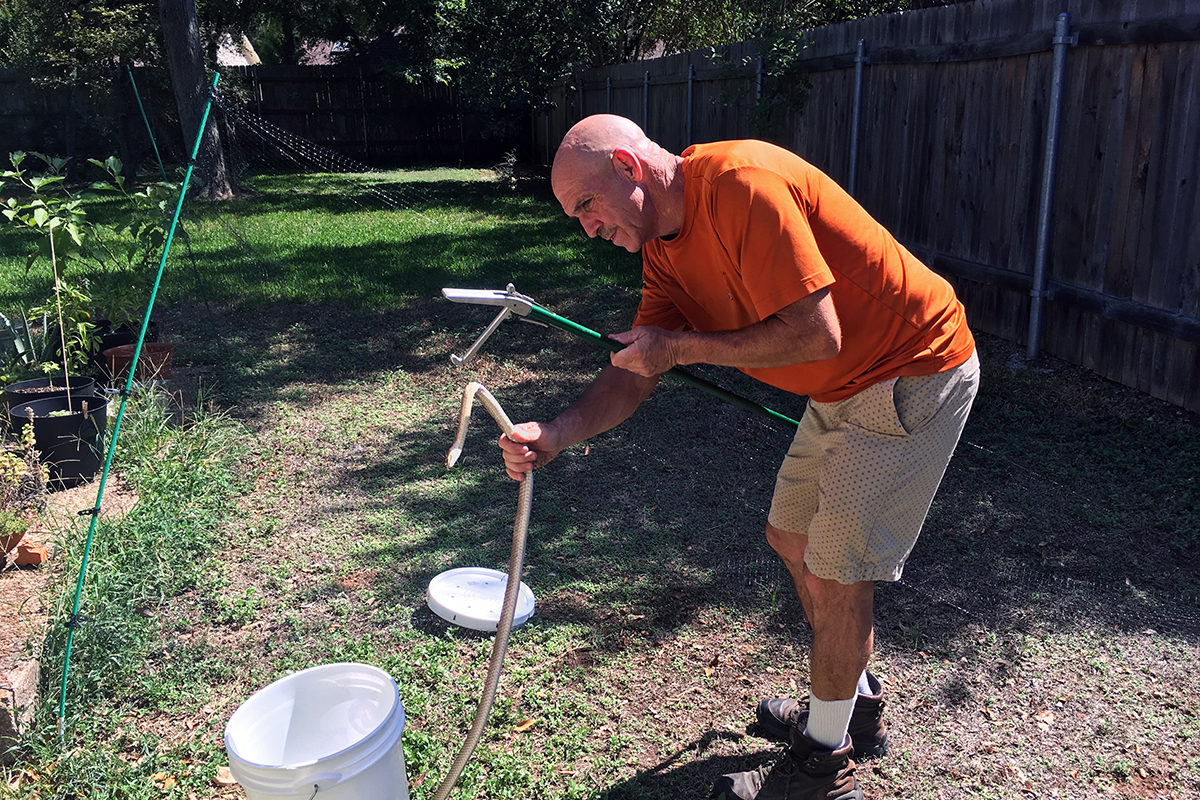On a blistering August afternoon in south Austin, Mike Dillon grabs a bucket and tongs and carefully extracts a coachwhip snake from the backyard of a resident who eagerly called for his help.
For Dillon, the phone rings a lot. On this day, hovering at 99 degrees, he arrives to relocate a live snake from the woman’s home. But to his dismay, it died of either suffocation or dehydration while tangled in a mesh net. The net cut through the length of its body.
“That is the reality,” Dillon says, sweating in the sun.
When it comes to animal removal, there are many happy relocation stories but, today, the Texas heat took its toll.
“That guy was just twisted too many times in that net. So any rate we’ll put the gear back,” he says.
Dillon said coachwhip snakes are known for playing dead. To be sure, he sprays cold water into a tall, white bucket and lowers the limp snake inside. No movement. Under different circumstances, the aerated bucket would have been a transport carrier, and Dillon would have found the animal a safe home across town.
“When that phone rings, you never know what kind of task is going to be at that end of the line,” Dilon said.
Dillon, owner of Critter Ridder Texas, an animal-removal company, researches and develops humane methods of removing unwelcome critters from homes. For more than 15 years, he has grown a business that provides urban trapping, control or removal.
Animal removal is a growing industry, and Dillon’s company responds to everything from rats to raccoon removal. Although Dillon strives to safely relocate every animal removed from residential areas, rats are a different story. According to city code, all rats must be exterminated due to diseases they potentially may carry, such as typhus, murine or rat-bite fever.
Rather than poison, Critter Ridder uses humane methods, including releasing pheromones in the air, creating static noise or stringing up lights to lure animals out of an area. Pheromones are a chemical substance sprayed to intimidate the critter. For example, a male raccoon pheromone scent will be used to attract the female and her babies out of an area.
“There’s so many things we’ll notice that the average person will not, and that’s because we know exactly what to look for. I can’t stress enough the importance of having someone look at every property. Every house in Austin is a candidate for some sort of critter infestation,” Dillon said.
Steven Arawn, a critter consultation specialist, took to the job naturally, learning as he went.
Before moving to Austin, Arawn dedicated himself to spiritual training at The Modern Mystery School. There, he studied quantum physics, metaphysics and mind science. Aside from working for Critter Ridder, he “coaches people and helps them connect back to joy.” It’s a personal philosophy he brings to working with Critter Ridder.
“Firstly, [the business] allows me to be exposed to people,” he said. “I do have several people I have met through Critter Ridder that I work with one-on-one with coaching as well. So, I actually get to be kind of a walking billboard for who I am.”
“What got me on board [with Critter Ritter] is that Mike purchased a $5,000 drone,” he said.
They use the drone to capture pictures of the property in hopes of getting a better view of the tricky places to map out. Later, Arawn started trapping and setting out the pheromones and learning the trade. He became the “special projects guy.”
“I’m kind of like the geek for the place, figuring out any of the technology that we’re working through,” he added.
Because they have to dive into the interior and exterior of people’s homes, employees at Critter Ridder have to easily build trust and show their competence — and fast. They’re polite, transparent and courteous, plus funny and quick on their feet.
Late in the afternoon, Arawn walks the exterior of an older home. His boots swish through the dry grass as he checks the home’s condition. He points upward toward a critter nest lodged inside the woodwork. The residents have got rats, squirrels and perhaps more.
“Rats want to stick to an area where their whiskers are always going to touch the sides, because they don’t see so well. They excrete a little bit of oil from their belly. That allows a scent trail for the next rat to figure out where to go,” he said.
After completing the job, he walks outside and takes off his gloves. Just then, a neighbor spots the Critter Ridder truck and rushes over. He tells Arawn he has rat issues as well. And so do other neighbors.
“It’s the whole city, man,” Arawn says.




